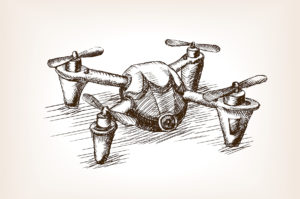Drones are by no means new technology, but their list of uses and applications appear to be never-ending. Drones can exist in a variety of forms with aerial, underwater and ground tending to be the three most popular categories. To create a more comprehensive guide we’ve split this into a two-part series. In part one we’ll be covering the main types of aerial drones.
Single-rotor helicopter
View this post on InstagramA post shared by Dezy (@cinetoys88) on
Single-rotor helicopters tend to resemble a more traditional helicopter, with a single rotor over the body to hold it up and a tail rotor to control its heading. Single-rotor helis tend to be more efficient than multi-rotors as they have larger rotor blades which spin slower. These drones are powered by gas motors which also improves their flight times and endurance. Whilst single-rotor heli drones can hover with heavy payloads and have longer endurance for flights, they tend to be more complicated to operate (they are less stable when flying and can be difficult to land) and more expensive to both purchase and maintain.
Multi-rotor helicopter
Multi-Rotor drones are arguably one of the most popular categories in the drone world. Known for being one of the easiest to operate styles and at the cheaper end of the scale, these are perfect for getting a camera in the air. Whilst they are easy to control, they have limited speed and endurance during flights as they are powered by electric motors. From an aerodynamic perspective, these drones are fundamentally inefficient since they require a large amount of energy to keep them in the air and the addition of weight from cameras make the fight against gravity that much more challenging. Although perfect for short flights, these drones are not ideal for larger projects like aerial mapping or area inspections.
Aeroplane or Fixed Wing
Fixed wing or aeroplane drones follow the model of traditional aeroplanes, using wings to provide lift rather than vertical lift rotors. As a result, they are much more efficient as they only use energy to move forward rather than to hold themselves in the air. This enables the drone to fly long distances and map larger areas, however, stops them from being able to hover in one spot and makes both launching and landing the drone more complicated. Depending on the size of the drone runways may be required for launches and landings. These drones can use gas engines which also contributes to their longer flight time. The costs of these drones can also get quite high, and a fair amount of flying skill is required to safely operate the drone without damaging it.
View this post on InstagramA post shared by Action Drone USA (@actiondroneusa) on
Powered lift
View this post on InstagramA post shared by AviAssist (@aviassist) on Sep 10, 2019 at 10:04pm PDT
Powered lift drones are similar to helicopters in the way they are able to take off and land vertically, however once in the air are able to move into forward flight similar to an aeroplane.



